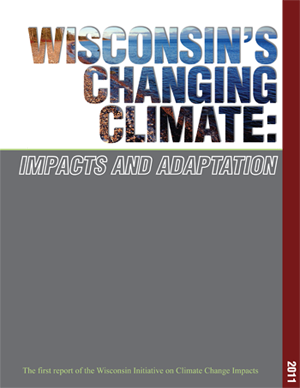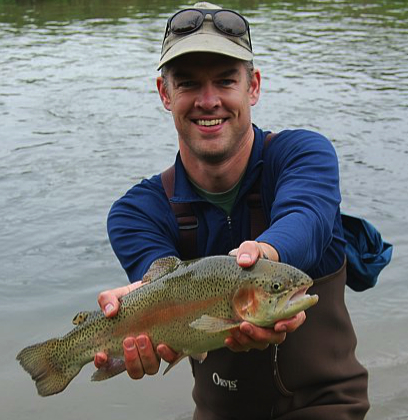June 9, 2014
WICCI and the Science / Policy Conversation
Posted by kcompton
By Dan Vimont, co-chair, Wisconsin Initiative on Climate Change Impacts (WICC)
I am a climate scientist who has spent my career understanding the physics of the climate system, and the impacts of climate variability and climate change. I am a co-chair of the Wisconsin Initiative on Climate Change Impacts (WICCI), an effort to understand and prepare for the impacts of climate change that now includes over 200 individuals around Wisconsin. As an individual, I am the wrong person to ask about what climate change means to some specific element of our society. There is no right individual, and there never will be. And, that’s the point.
Stick with me here as I try to provide an example. I like to fly fish for trout, which is one (albeit way down the list) of the reasons why I’m not a fan of climate change in Southwestern Wisconsin’s Driftless Area. I’m no trout scientist, but I do know that trout need cold water to live. How cold? I don’t know – I don’t study trout that closely. But I do know that our projections for the region indicate a warming of about 4-9F by the mid-21st century for Wisconsin. So, when I was asked to talk about climate change at a 2007 meeting between scientists at the University of Wisconsin-Madison and scientists and managers at the Wisconsin Department of Natural Resources (DNR), I was excited to see that I would be speaking back-to-back with Matt Mitro, a fisheries biologist studying stream temperatures and trout in Wisconsin. He does know “how cold”, and can point to specific studies that document the impact of stream temperatures on trout mortality. Those talks started a conversation about what data and actions were needed to assess the risk of climate change to trout population in Wisconsin. I’ll get back to this example in a minute.
That meeting in 2007 began a much larger conversation, and during the following summer, WICCI was formed. To be specific (and perhaps overly academic), WICCI was formed as a boundary organization that enables the conversation that needs to occur between scientists, managers, and policy-makers across a wide range of specific impacts. Early in its existence, WICCI recognized the importance of the conversation – in order for climate and other scientists to produce relevant information we needed to know what specific information was needed from different vulnerable sectors. And, in order to identify vulnerability and assess impacts of climate change on those sectors, other scientists, managers, and policy-makers needed credible climate information. This cross-boundary conversation is not just a good idea, it’s necessary in order to define the problem in the first place.
WICCI grew as a decentralized boundary organization (its organizational structure is based on theories of management structures within complex adaptive systems, but that’s a topic for a different post). The decentralization means that WICCI has never been prescriptive about what its members do. As a result, WICCI’s various foci emerge from the interests of engaged members. Currently, those foci span sectors such as agriculture, climate, human health, wildlife, stormwater, etc., and regions such as Milwaukee, Green Bay, the Central Sands, and so forth. As a boundary organization WICCI scans the “landscape” of potential climate impacts (from science and stakeholder perspectives), and sets up working groups around specific topics (boundary objects, to draw from a social science construct). As those working groups progress, they identify new knowledge gaps and priorities and the network continues to evolve.
 In 2011 WICCI published it’s first report, “Wisconsin’s Changing Climate: Impacts and Adaptation.” The report comprises the work of the growing WICCI network, which now includes more than 200 individuals representing over 70 different public, private, and non-governmental organizations around Wisconsin and the Midwest. Since then, WICCI has contributed to over 150 talks, workshops, and conferences around Wisconsin, and is being used to motivate specific adaptation activities around the state. The latter is a fascinating result to me: even though WICCI has no mandate and is an open, decentralized network, its mere existence provides legitimacy to its mission. What is even more interesting to me is that I don’t think WICCI would have any legitimacy if it were only me, as a climate scientist, providing information about climate change. By engaging in the conversation with individuals who are responsible for making the decisions in the first place, WICCI’s legitimacy extends far beyond the scope of any one of its components.
In 2011 WICCI published it’s first report, “Wisconsin’s Changing Climate: Impacts and Adaptation.” The report comprises the work of the growing WICCI network, which now includes more than 200 individuals representing over 70 different public, private, and non-governmental organizations around Wisconsin and the Midwest. Since then, WICCI has contributed to over 150 talks, workshops, and conferences around Wisconsin, and is being used to motivate specific adaptation activities around the state. The latter is a fascinating result to me: even though WICCI has no mandate and is an open, decentralized network, its mere existence provides legitimacy to its mission. What is even more interesting to me is that I don’t think WICCI would have any legitimacy if it were only me, as a climate scientist, providing information about climate change. By engaging in the conversation with individuals who are responsible for making the decisions in the first place, WICCI’s legitimacy extends far beyond the scope of any one of its components.
Let’s get back to trout fishing (you’d be amazed at the number of situations for which that recommendation is a good one). The conversation through WICCI between fisheries biologists and climate scientists led to a 2010 study showing that brook trout (the only native trout in Wisconsin) and brown trout habitat would be drastically reduced, or eliminated from Wisconsin by the mid- to late-21st century (since then, incorporation of hydrologic processes has slightly reduced the projected risk of elimination to a drastic reduction). Updated projections, together with WICCI science, were used by the Wisconsin DNR in a revision of their Driftless Area Master Plan for the more than 35,000 acres of land that the agency manages for public fishing access. In a series of conversations around the region, the DNR presented results to engaged citizens and users of those public lands, and asked them what their priorities would be in light of these climatic changes, and other important factors. This is a message that WICCI has been promoting for a while, and is echoed in the recent National Climate Assessment: climate change is not always the main driver for a decision, but is part of a larger conversation about sustainability.
The Driftless Area Master Planning example, together with a number of other examples of climate adaptation that are motivated by WICCI science, outline WICCI’s model for climate adaptation:
1) WICCI engages scientists, managers, and policy-makers in a conversation to identify information needs and to fill knowledge gaps about specific vulnerabilities and impacts of climate change.
2) WICCI does not make recommendations about specific actions that should be taken! Instead, WICCI works with decision-makers to interpret relevant information, and to help them make informed decisions.
As WICCI moves forward, we hope to continue our success with part (1), and to develop and expand part (2) of our model for climate adaptation. We are already moving in that direction with a slightly revised organizational structure, an energized Outreach and Communications group, and an engaged set of members.
Moving forward, I’m excited about the conversation. In addition to motivating real climate adaptation, the conversational model means that, selfishly, I get to learn about the many impacts of climate change in our region from the best people in the business – the managers and citizens of our state who are deal with those impacts on a day-to-day basis. This is the Wisconsin Idea embodied.
So, I individually am the wrong person to ask about a specific impact of climate change. But together, we can make real progress. Let’s talk.
Dan Vimont is an Associate Professor in Atmospheric and Oceanic Sciences at the University of Wisconsin – Madison, and in the Nelson Institute Center for Climatic Research. His research focuses on mechanisms of climate variability and climate change, relationships between climate variability and weather events, and on regional climate impacts. Dan is a co-chair of the Wisconsin Initiative on Climate Change Impacts (WICCI). Dr. Vimont will be speaking at the 2014 AGU Science Policy Conference on June 17th.


